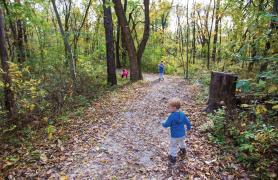Dave Niebruegge drove past flames creeping toward a two-lane blacktop on a dry, warm, and windy late-winter day. It was the perfect conditions for dangerous wildfires. Smoke from several fires drifted for miles over the wooded, rolling hills of southeast Benton County, threatening a few homes.
“That one will burn itself out when it hits the road,” said Niebruegge, an MDC private land conservationist and trained and experienced firefighter. “Other fires are scattered all over.”
So he drove on, and about 5 p.m., he turned into a driveway and parked near a farmhouse with a large red barn nearby. Fire had blackened pastures to the south and smoke curled up from charred forest a few hundred yards to the west. Volunteer firefighters and MDC fire crews stood in the yard, watching the smoke and hoping embers didn’t jump a fire line.
James and Diane Ruffner watched, too, as smoke drifted toward their home.
“It was burning up on that hill last night,” said James. “During the night, it came down behind us and we were just about engulfed.”
Providing Critical Help
Luckily, both community volunteers and MDC firefighters responded when the Ruffners called for help. Volunteers from the Deer Creek Fire Protection District and the Northwest Fire Protection District worked fires in the area using gear that an MDC program helped them obtain. One of MDC’s bulldozers helped etch a fire line through the timber between the wind-pushed fire and the house.
“The Conservation Department’s help is very important to us,” said John Spry, fire chief for Deer Creek. “Both the equipment we get and the help we get when we fight a fire, they’re big assets to us.”
MDC provides critically important support for rural fire departments throughout Missouri. When grass, brush, or forest fires occur, MDC personnel trained to fight wildfires respond to assist. The volunteer fire crews they help are often using trucks, protective gear, tools, and radios procured with help from a federal surplus equipment program and MDC’s Volunteer Fire Assistance Matching Grant Program. Federal agencies such as the U.S. Forest Service (USFS) are partners. The agency proudly helps communities protect property and conserves quality wildlife habitat from destructive blazes.
Last year, MDC provided $338,490 to 156 rural fire departments. Grants and surplus equipment goes to fire departments who serve 10,000 residents or less. The program allows small departments to acquire safety gear and equipment they would not otherwise be able to afford. More than $7.5 million in assistance went to rural fire departments over the past 30 years.
“These grants mean increased safety for the firefighters and better protection in forested areas of the state,” said Ben Webster, forest field programs supervisor with MDC.
The Deer Creek and Northwest fire districts each received almost $3,000 in grants in 2016 to purchase radios. Communication is critical when fighting fires over broad, broken terrain.
Reporting to the Scene
About 5:30 p.m., the radio in Niebruegge’s pickup crackled with a message.
“There’s a fire up here threatening a house and nobody’s on it yet,” a voice says.
Niebruegge drove down another winding, two-lane blacktop toward thick, white smoke pulsing skyward in the general vicinity of a hamlet called Edwards, south of Lake of the Ozarks’ upper end. A wildfire was on the move through leaves and grass.
“That’s fresh smoke there,” he said.
MDC personnel are not allowed on a fire line unless they’ve been trained in firefighting safety, wildfire behaviors, causes, and methods to extinguish. Many have worked on multiple fires. MDC also loans trained firefighters to help states in the West battle major wildfires ravaging large areas. The USFS bears the cost of their services, and the crews bring techniques and experience back to apply to Missouri fires.
Missouri wildfires are rarely as large as fires in the West that make national news reports. Our higher humidity helps. So do roads and farm fields that make creating fire barriers easier. However in late winter, early spring, drought summers, or autumn, conditions can ripen for large fires. If it is your house, barn, or turkey woods in the fire’s path, it’s severe.
Good Fire Versus Bad Fire
Not all fires are bad. Prescribed burns use fire to improve habitat for wildlife or manage forage cover. But those fires are under conditions with moderate humidity and temperatures, light winds, and the knowledge that the fuel load for the fire is safe.
Wildfires, however, can burn destructively when pushed by high winds through heavy fuels with low humidity and warm temperatures. They are dangerous to people, property, and natural areas. Wind can blow sparks and embers to light fires beyond the main fire.
“They can move very quickly and be hard to catch,” Niebruegge said.
Careless trash and leaf burning, lit cigarettes tossed from car windows, or even sparks from machinery can start fires when conditions are ripe. Authorities investigated the Benton County fires that MDC crews helped battle in February 2016 as possible arsons.
Back on the Scene
MDC crews and volunteers began fighting those blazes near Edwards as dusk fell about 6 p.m. The fire had scorched a grassy meadow and now burned a few miles through forest. Lights flashed atop fire district trucks. Pungent smoke from burning leaves and the acrid scent of burnt wood drifted through oak, hickory, and walnut trees.
“MDC is going to go down the hill and attack it and use blowers to build a fire line and keep it from those houses,” Niebruegge told the volunteers.
Another MDC fire crew chief had scouted the area and developed a plan. The volunteers agreed to approach the fire from another side, close to a nearby house. Experienced fire crews don’t just go in and swat flames. They plan attacks. They decide who is going where, and what radio channels will be used for communication.
“If we’re not coordinated,” Niebruegge said, “we could lose control of a fire, or even worse, get a firefighter hurt.”
Cory Gregg, an MDC resource forester, and Vince Belfiore, an MDC resource assistant, strapped on powerful backpack blowers. Motors hummed like chainsaws as they used the air blowers to push thick leaf litter and sticks to one side, creating a 4- to 6-foot wide fire line. Dusk dimmed light and the smoke became more ghostly.
Up and down steep hills, Gregg and Belfiore worked in a line aimed at getting ahead of a fire advancing through the woods. Darkness fell, making it harder to spot sure footing. Flames from a few inches to a few feet high flickered and shimmered, pushed by a west wind and pulled by dry leaves and downed limbs ready to burn. Wind provides more oxygen that makes fires burn hotter and faster. Fire sometimes makes its own air currents, too, especially when burning uphill.
A wildfire is not steady flames like turning on a gas-stove burner or burning a pile of leaves in a yard. Instead, random snaps and pops echo steady amid combustion with no human control. Flames move through leaves and underbrush at varied paces. They leap upward when catching downed limbs and dead trees on fire. In this blaze, a sudden rise in the breeze pushed intense heat across the fire line, a reminder that fire can harm as it consumes.
By 8 p.m., the fire crew armed with blowers made a westward turn, still hiking up and down hills. Niebruegge trailed several hundred yards behind and tamped out hotspots along the fire line. He used a drip torch to set backfires on the upwind side of the fire line to reduce fuel in front of the advancing wildfire, and he backtracked at times to make sure the fire had not jumped the line. A dead tree snag was pushed down so it would not catch fire and fall on someone or onto the unburned side of the fire line. The men worked in darkness, except for headlamps and orange glows from the long, unbroken line of flames on the upwind side of the fire line.
They paused at an old farm road, where they met with other fire crews and volunteers. But the fire had jumped the road and drifted toward a house. A resident there had been trying to build a fire line with a broom. So the crews in sooty, flame-retardant clothes headed west again and cleared more fire line until the house and the neighborhood was safe. Weary firefighters waited for rides back to their vehicles as 10 p.m. neared.
Chief John Spry said the help MDC fire crews provide to volunteers and communities when fighting a big wildfire is critical.
“Their expertise of how to contain a fire has helped us in the past,” Spry said. “It makes it safer and easier for everyone. And there’s times when we can’t fight a fire without that dozer.”
But sometimes in Missouri’s rugged countryside, a fire is squelched with rakes, shovels, blowers, and elbow grease, mostly like MDC employees have been doing in the state’s forests for three-quarters of a century.
“That’s often why we’re called,” Niebruegge said. “We have the hand crews that can backpack into a fire and stop it before it gets to structures, as well as more timber.














Also In This Issue


And More...
This Issue's Staff
Art Director - Cliff White
Associate Editor - Bonnie Chasteen
Staff Writer - Heather Feeler
Staff Writer - Kristie Hilgedick
Staff Writer - Joe Jerek
Photographer - Noppadol Paothong
Photographer - David Stonner
Designer - Les Fortenberry
Designer - Marci Porter
Designer - Stephanie Thurber
Circulation - Laura Scheuler






















